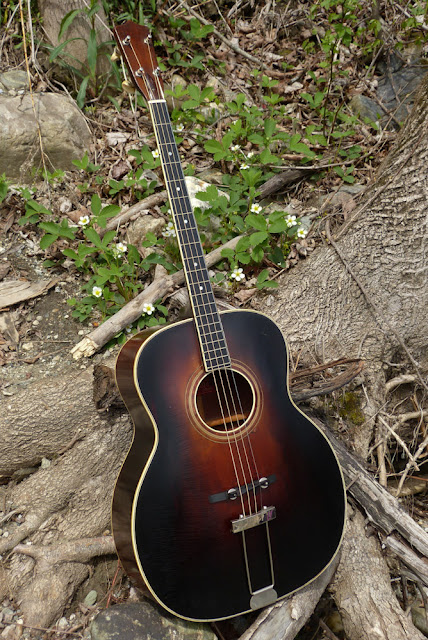1932 Regal-made Bacon X-Braced Archtop Tenor Guitar
Ah, bacon strewn in a patch of wild strawberries...
This instrument is rare as heck. Bacon, of course, made some of the most high-profile banjos back in the 20s and 30s, though their guitar offerings are less-well-known. The reason is simple: not many were made and they were all made by other makers rather than Bacon (at the time in Groton, CT) themselves. This does have a standard Bacon serial number that dates it to 1932, however, which makes sense for the build-style and hardware.
This instrument is rare as heck. Bacon, of course, made some of the most high-profile banjos back in the 20s and 30s, though their guitar offerings are less-well-known. The reason is simple: not many were made and they were all made by other makers rather than Bacon (at the time in Groton, CT) themselves. This does have a standard Bacon serial number that dates it to 1932, however, which makes sense for the build-style and hardware.
Regal in Chicago made most (or all?) of the guitar-type instruments for Bacon (before the Bacon name was sold to Gretsch) as far as I know. In fact, the only other comparable tenor guitar I've seen happens to be one I worked-on and owned for a while. I'm sure that this one was also made by Regal, and while there are similarities in the models, this Bacon one is many steps above the other in terms of grade. It's easily in the realm of Gibson or Martin quality -- something the Regal "custom shop" models are known for as well (in the early 30s Regal was pushing a line of high-quality instruments that ended-up being used by brands like Washburn and Bacon).
For its time, this guitar was thoroughly modern. It's has an arched-top and arched-back and a shape reminiscent of an 0-18T tenor guitar save that it's actually 00 in size. Regal fussed with this body style for about 20 years -- here's their take on an 0-18T flattop-type guitar that shares a similar body mold. It's also x-braced on the top in a pattern similar to a flattop rather than an archtop x-braced guitar (this is totally interesting) which is something that's more familiar on modern archtop guitars and mandolin-family instruments. The neck is also slim and fast (like a 50s/60s Gibson tenor guitar) and has a big, non-adjustable truss rod installed. These are quite-strange features for the time.
There are a number of Regal-made Bacon collectors, these days, and they all know the truth of how high-quality these are -- from simpler mandolins all the way up to highly-ornate archtop 6-strings.
I received this guitar in trade and it's had a number of old repairs (mostly cracks on the back) done to it (all holding well), but it really needed a bit more to get it going 100%. There was a fretboard section that needed regluing, the frets needed to be seated and leveled/dressed properly, one brace needed regluing, and it desperately needed a good setup. All that's done and it plays spot-on with a nice, straight neck. Action is easily-adjustable but I have it set for hair-above 1/16" on the lowest string and 1/16" overall for the others at the 12th fret.
I've strung it for GDAE (octave mandolin) tuning with strings in gauges 42w, 30w, 18w, 12. With the light build and 23" scale this is more than enough power for this thing to bark like crazy. It's loud, warm, sustained, and has a rich voice for an archtop. It still has that zing and punch, though. To my ears it actually sounds more like a modern, guitar-bodied octave mandolin than an old tenor guitar in its voicing (I mention that because it has smooth mids/bottom and a creamy top rather than a "zip zip" sound).
I haven't even talked about woods -- this has a solid spruce top and solid mahogany back, sides, and neck. The fretboard is ebony and the headstock veneer is rosewood. The bridge has a maple (stained) base and an ebony top.
The headstock is cut "uke style" and looks great. The "truss rod cover" is actually just a cover-plug for the non-adjustable rod install. It's elegant and rosewood. The tuners are geared, banjo-style units and the nut is bone and 1 1/8" in width.
The neck profile is a slim, soft-V shape. The ebony board is bound, flat-profile, and has pearl dots and side dots. The frets are those Regal-style tall and thin ones. They've leveled/dressed-up nicely but if you're the kind of player who strangles a neck when doing slides, they're not going to be desirable to you (I suggest medium or larger frets for those kind of hands).
All the trim is classy and subdued and the finish is a nice, dark sunburst. It's been touched-up here and there (mostly on the back) around repaired cracks but, overall, has that nice "antique" patina. Note the weather-check in the next pic.
As noted, the bridge has a maple base and ebony top. It's adjustable and very-well-cut. Depending on how you move it around, the simple compensated top will work for a variety of tunings/stringings.
Handsome, huh?
The lower bout is 14 1/4" across and the side depth measures from 3 1/2" near the neck to 4" at the tail.
The mahogany back is arched and has several old, long hairline cracks. They've all been repaired in the past and some have wood cleats while others have the old-style "cloth repair." None are open or funky.
The neck angle is good to go.
Another nice bit is the 100% originality -- right down to the endpin.
Here's the big non-adjustable rod's termination point in the body.
Here's the x-bracing.
Here's another shot of some of the cloth-backed old crack repairs.
It also comes with an original chip case in good shape.





























Comments